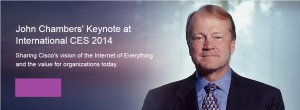Cisco Chairman and Chief Executive Officer (CEO) John Chambers, as expected, used his CES-2014 platform to focus on the Internet of Things (IoT), or as Cisco, calls it, the Internet of Everything (IoE).
Chambers shared his vision for the IoE, the networked connection of people, processes, data and things, during Tuesday afternoon’s keynote address. Chambers begun by making two predictions, including “2014 will be the transformational and pivotal point for the Internet of Everything,” and “the Internet of Everything will be five to ten times more impactful in the next decade than the entire internet has been to date.”
 The Silicon Valley networking giant had earlier emphasised the figure $14.4 trillion with the IoE by 2020. Chambers communicated the potential of embracing IoE by outlining the US $19 trillion savings that could be realised in the private and public sector. He cited several examples, including the US $13 billion a year alone that is spent on street lighting that could be reduced by 70 percent by using connected technology. The keynote included an extensive demonstration of Cisco’s Videoscape, a cloud-based home entertainment service as well as a description of the Digital Life Project, a home automation initiative.
The Silicon Valley networking giant had earlier emphasised the figure $14.4 trillion with the IoE by 2020. Chambers communicated the potential of embracing IoE by outlining the US $19 trillion savings that could be realised in the private and public sector. He cited several examples, including the US $13 billion a year alone that is spent on street lighting that could be reduced by 70 percent by using connected technology. The keynote included an extensive demonstration of Cisco’s Videoscape, a cloud-based home entertainment service as well as a description of the Digital Life Project, a home automation initiative.
The Futurecast Keynote address featured panelists John Donovan of AT&T, Qualcomm’s Paul Jacobs and Ericsson’s HansVestberg who collectively discussed the power of mobile in today’s world, and the future of wireless networks. All three panelists stressed the importance of mobile as a platform for creation. “When you give consumers the freedom to use bandwidth, they’ll use it,” said Donovan, “the phone is the remote control for your life.”
Donovan said that AT&T is becoming more of a software-oriented company focused on users, and enabling content creation. Efficiency was also a hot topic (both power and spectrum efficiency). “When we think about the Internet of Everything, we want these sensors to be very low power,” said Jacobs as he discussed wireless charging, explaining that the Formula-E racing circuit will use wireless charging, first for support cars, then eventually for the electric Formula-E cars themselves. Vestberg predicted that in the next three to four years, small cells to help handle 4G traffic (both indoor and out) will be prominent.
Image Credit: Cisco
– Advertising Message –
